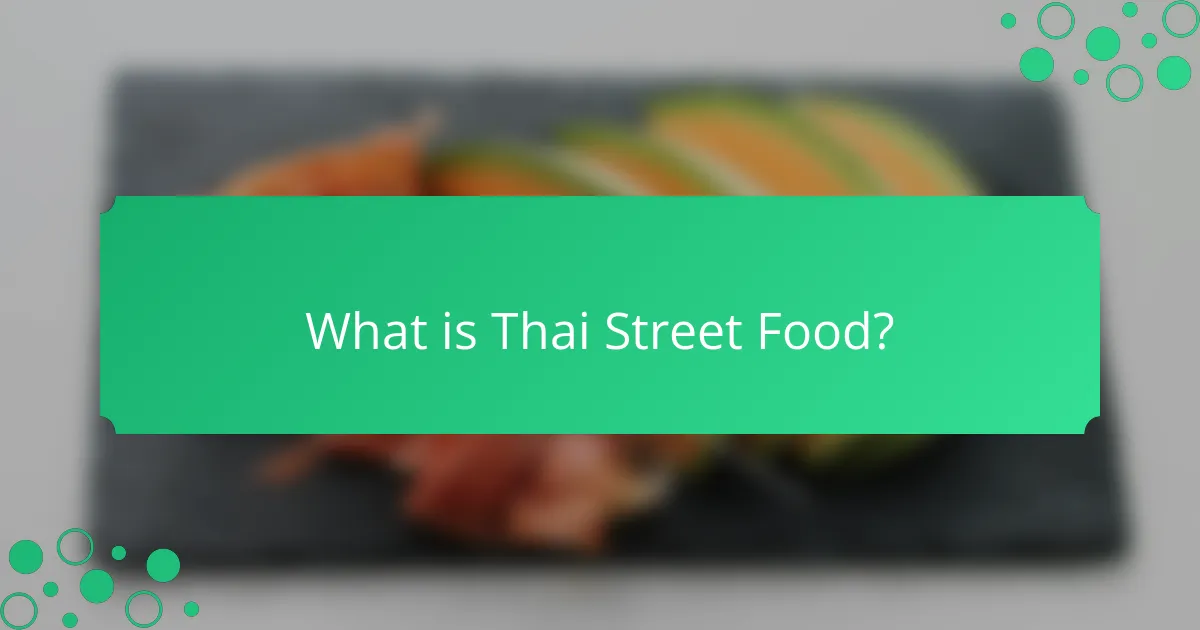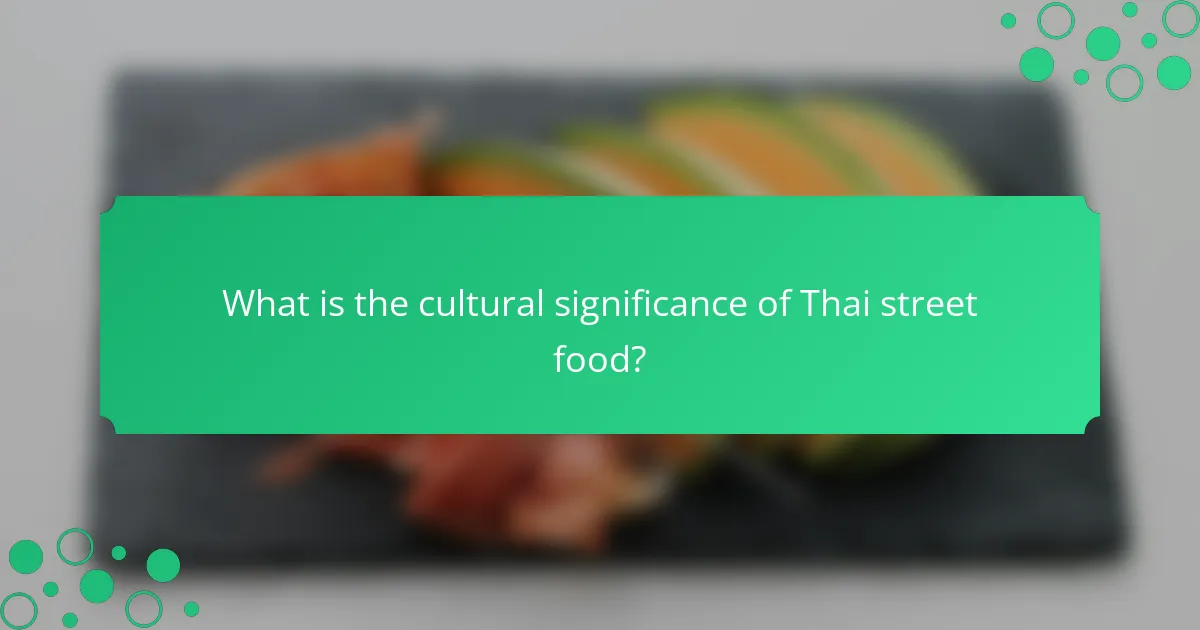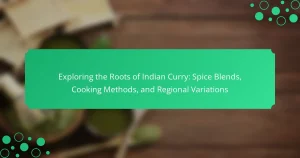Thai street food encompasses a diverse array of affordable and flavorful dishes sold by vendors throughout Thailand, including popular items such as Pad Thai, Som Tum, and Satay. These dishes are characterized by their use of essential ingredients like rice, noodles, fresh herbs, and spices, which contribute to the vibrant flavors of Thai cuisine. Street food plays a crucial role in Thai culture, offering a communal dining experience that fosters social connections and showcases regional specialties. The popularity of Thai street food has extended globally, influencing food culture and attracting tourists seeking authentic culinary experiences. Additionally, street food markets often serve as cultural hubs, promoting local art, music, and crafts, further emphasizing Thailand’s rich cultural heritage.

What is Thai Street Food?
Thai street food refers to a variety of affordable, flavorful dishes sold by vendors on the streets of Thailand. It encompasses a wide range of culinary options, including noodles, rice dishes, and snacks. Common ingredients include fresh herbs, spices, and local produce. Popular dishes like Pad Thai and Som Tum showcase the vibrant flavors characteristic of Thai cuisine. Street food is integral to Thai culture, offering a social dining experience. Many vendors operate from mobile carts or small stalls, making food accessible to all. The popularity of Thai street food has grown globally, influencing food culture beyond Thailand.
How did Thai street food originate?
Thai street food originated from the need for convenient, affordable meals among urban populations. In the mid-20th century, rapid urbanization in Thailand led to a rise in street vendors. These vendors offered quick meals to workers and passersby. Traditional Thai dishes were adapted for easy preparation and consumption on the go. The influence of regional cuisines also shaped street food offerings. Ingredients were often locally sourced, enhancing freshness and flavor. Over time, street food became a cultural staple and a reflection of Thailand’s diverse culinary heritage. Today, it is celebrated for its variety and accessibility.
What historical influences shaped Thai street food?
Thai street food is shaped by various historical influences, including trade, immigration, and cultural exchange. The ancient trade routes brought spices and cooking techniques from India and China. These influences introduced flavors and ingredients that are now staples in Thai cuisine. Additionally, the migration of Chinese communities to Thailand in the 19th century popularized dishes like noodle soup and stir-fries. The street food culture also evolved during the post-World War II era, as urbanization increased and more people sought affordable meal options. Furthermore, the rise of tourism in the late 20th century highlighted street food as a key aspect of Thai culture, attracting both locals and visitors. These historical factors collectively shaped the diverse and vibrant landscape of Thai street food today.
How has urbanization impacted the growth of Thai street food?
Urbanization has significantly fueled the growth of Thai street food. Increased population density in urban areas has created a higher demand for quick and affordable dining options. Street food vendors have responded by expanding their offerings to cater to diverse tastes. The convenience of street food aligns with the fast-paced lifestyle of city dwellers. Additionally, urbanization has led to a rise in tourism, further boosting the visibility of street food. According to the Thailand Street Food Association, street food contributes to over 30% of the country’s food market. This growth reflects both local preferences and international interest in Thai cuisine.
What are the defining characteristics of Thai street food?
Thai street food is characterized by its bold flavors, variety, and accessibility. It typically features fresh ingredients and a balance of sweet, sour, salty, and spicy tastes. Common dishes include Pad Thai, Som Tum, and various curries. Street vendors often prepare food quickly and serve it in convenient portions. The vibrant presentation enhances the appeal of these meals. Street food is deeply rooted in Thai culture and often reflects regional specialties. It provides an affordable dining option for locals and tourists alike. The social aspect of eating street food fosters community interaction.
How does the flavor profile distinguish Thai street food from other cuisines?
Thai street food is distinguished by its vibrant and complex flavor profile. It typically combines sweet, sour, salty, and spicy elements. Ingredients like lemongrass, galangal, and kaffir lime leaves contribute aromatic qualities. Dishes often feature fresh herbs, chilies, and fish sauce, enhancing depth and umami. This balance of flavors creates a unique culinary experience. In comparison, many other cuisines may emphasize one or two dominant flavors. The interplay of contrasting tastes in Thai street food sets it apart. Additionally, the use of fresh, local ingredients provides a distinct freshness. This emphasis on flavor complexity is a hallmark of Thai culinary tradition.
What role does presentation play in Thai street food culture?
Presentation plays a significant role in Thai street food culture. It enhances the visual appeal of dishes, attracting customers. Vibrant colors and artistic plating highlight the freshness of ingredients. This attention to detail reflects the care and skill of the vendors. Street food stalls often showcase beautifully arranged food to entice passersby. A well-presented dish can elevate the dining experience and influence customer choices. In Thailand, food presentation is considered an art form, contributing to the overall enjoyment of the meal.

What are the most popular Thai street food dishes?
The most popular Thai street food dishes include Pad Thai, Som Tum, and Satay. Pad Thai is a stir-fried noodle dish made with rice noodles, eggs, tofu, and shrimp, often garnished with peanuts and lime. Som Tum is a spicy green papaya salad that combines shredded papaya, tomatoes, and chili, usually served with sticky rice. Satay consists of marinated grilled meat skewers, typically served with peanut sauce and cucumber salad. These dishes are widely enjoyed for their flavors and affordability. They reflect Thailand’s rich culinary culture and are staples at street food stalls across the country.
Which dishes are considered must-try Thai street foods?
Must-try Thai street foods include Pad Thai, Som Tum, and Satay. Pad Thai is a stir-fried noodle dish, often made with shrimp or chicken. It is flavored with tamarind, fish sauce, and lime. Som Tum is a spicy green papaya salad, known for its tangy and spicy flavor profile. Satay consists of marinated grilled meat skewers served with peanut sauce. Other notable dishes are Khao Soi, a coconut curry noodle soup, and Moo Pad Krapow, stir-fried basil pork. These dishes reflect Thailand’s rich culinary heritage and regional flavors. Street vendors commonly serve them, making them accessible to locals and tourists alike.
What ingredients are commonly used in Pad Thai?
Common ingredients used in Pad Thai include rice noodles, shrimp, chicken, or tofu. Other key components are eggs, bean sprouts, and green onions. Additionally, peanuts, lime, and tamarind paste are essential for flavor. Fish sauce is often added for saltiness. These ingredients create a balanced dish that combines sweet, sour, and savory flavors. Pad Thai is a staple in Thai cuisine, showcasing the country’s culinary diversity.
How is Som Tum (Green Papaya Salad) prepared and served?
Som Tum (Green Papaya Salad) is prepared by shredding unripe green papaya. The papaya is typically mixed with ingredients such as tomatoes, green beans, peanuts, and chili peppers. A dressing made of lime juice, fish sauce, and palm sugar is added for flavor. The mixture is then pounded lightly in a mortar and pestle to blend the flavors. Som Tum is usually served fresh, often accompanied by sticky rice and grilled meats. It is commonly found at street food stalls in Thailand. The dish is known for its vibrant flavors and crunchy texture.
What regional variations exist in Thai street food dishes?
Thai street food varies significantly by region. In Bangkok, dishes like Pad Thai and Som Tum are prevalent. Northern Thailand features Khao Soi, a coconut curry noodle soup. In the northeast, known as Isan, grilled meats and spicy salads dominate, such as Larb and Nam Tok. Southern Thailand offers seafood-based dishes like Massaman Curry and Khao Yum, a spicy rice salad. Each region incorporates local ingredients and flavors, reflecting its cultural heritage. For instance, the use of fresh herbs and spices varies, impacting the overall taste profile of the dishes.
How does Northern Thai street food differ from Southern Thai street food?
Northern Thai street food is characterized by its use of herbs and spices, while Southern Thai street food is known for its bold flavors and coconut-based dishes. In Northern Thailand, dishes often feature ingredients like sticky rice, fresh vegetables, and meats grilled over an open flame. Popular dishes include Khao Soi, a curry noodle soup, and Sai Ua, a spicy sausage. In contrast, Southern Thai street food emphasizes seafood and rich coconut curries, with dishes like Massaman curry and Gaeng Tai Pla. This regional variation reflects the agricultural practices and cultural influences of each area. Northern cuisine tends to be milder, while Southern cuisine is spicier and more aromatic.
What unique dishes are found in Isaan street food culture?
Isaan street food culture features unique dishes such as Som Tum, Larb, and Khao Niew. Som Tum is a spicy green papaya salad mixed with chili, lime, and fish sauce. Larb is a minced meat salad, often made with chicken or beef, seasoned with herbs and spices. Khao Niew, or sticky rice, is a staple accompaniment to many Isaan dishes. Other notable dishes include Gai Yang, grilled chicken marinated in turmeric and served with a dipping sauce. Moo Pad Krapow is a stir-fried pork dish with basil and chili. These dishes reflect the region’s flavors and culinary traditions, emphasizing bold spices and fresh ingredients.

What ingredients are essential in Thai street food?
Essential ingredients in Thai street food include rice, noodles, fresh herbs, and spices. Rice serves as a staple base in many dishes. Noodles are commonly used in soups and stir-fries. Fresh herbs like cilantro and basil enhance flavor and aroma. Spices such as chili and garlic add heat and depth. Fish sauce provides a salty umami taste. Coconut milk is used in curries and desserts. Lime juice adds acidity and brightness to dishes. These ingredients are foundational to the vibrant flavors of Thai street food.
What are the staple ingredients used in Thai street food?
Thai street food commonly features ingredients such as rice, noodles, fresh herbs, and spices. Rice is a staple, often served as a base for many dishes. Noodles, including rice and egg varieties, are also prevalent in street food offerings. Fresh herbs like cilantro, basil, and mint add distinctive flavors. Spices such as chili, garlic, and ginger provide heat and depth. Additionally, proteins like chicken, pork, and seafood are frequently used. Vegetables, including bean sprouts and carrots, enhance texture and nutrition. These ingredients reflect the vibrant flavors and culinary traditions of Thailand.
How do herbs and spices enhance the flavors of Thai street food?
Herbs and spices are essential in enhancing the flavors of Thai street food. They add depth and complexity to dishes. Common herbs like cilantro and basil provide freshness. Spices such as chili and garlic contribute heat and aroma. The balance of sweet, sour, salty, and spicy flavors is achieved through these ingredients. For example, lemongrass adds citrus notes, while fish sauce provides umami. These elements create a harmonious taste profile. Thai street food is celebrated for its vibrant flavors, largely due to these herbs and spices.
What role does rice play in Thai street food dishes?
Rice is a staple ingredient in Thai street food dishes. It serves as a base for many meals, complementing various flavors and textures. Common forms of rice used include jasmine rice and sticky rice. Jasmine rice is light and fragrant, enhancing the overall taste of dishes. Sticky rice is often paired with grilled meats or served with desserts. Rice absorbs flavors from accompanying sauces and ingredients, making it essential for balance. According to the Thai Food and Drug Administration, rice consumption in Thailand is among the highest globally. This highlights its cultural significance and versatility in Thai cuisine.
How do seasonal ingredients influence Thai street food offerings?
Seasonal ingredients significantly influence Thai street food offerings by dictating the availability and variety of dishes. Street food vendors adapt their menus based on what is fresh and in season. For example, during the rainy season, vendors often use ingredients like mangoes and durians, which are abundant at that time. In contrast, the dry season sees an increase in dishes featuring fresh herbs and vegetables. This practice not only enhances the flavor profile of the food but also aligns with local agricultural cycles. Additionally, using seasonal ingredients supports local farmers and promotes sustainability. The emphasis on freshness reflects the traditional Thai culinary philosophy of balancing flavors and textures. Thus, seasonal ingredients play a crucial role in shaping the dynamic landscape of Thai street food.
What are some examples of seasonal dishes in Thai street food?
Thai street food features several seasonal dishes. One example is “Khao Chae,” traditionally served during the hot season. This dish consists of rice soaked in jasmine-scented water, accompanied by various side dishes. Another seasonal dish is “Som Tum,” a green papaya salad, which is popular during the rainy season. It is made with shredded unripe papaya, lime, and chili. “Khanom Jeen Nam Ya” is often enjoyed during the Songkran festival. This dish includes rice noodles topped with spicy fish curry. Each of these dishes reflects the seasonal ingredients available in Thailand.
How do local markets contribute to ingredient availability for street food vendors?
Local markets significantly enhance ingredient availability for street food vendors. They provide a diverse range of fresh produce and local products. Vendors can source ingredients directly from farmers and suppliers. This reduces transportation time and costs. Local markets often feature seasonal ingredients that reflect regional culinary traditions. Freshness is crucial for street food quality and flavor. Additionally, local markets foster community relationships between vendors and suppliers. This collaboration ensures a consistent supply of necessary ingredients.

What is the cultural significance of Thai street food?
Thai street food holds immense cultural significance as it reflects the country’s culinary heritage and social fabric. It serves as an accessible and communal dining experience for people from all walks of life. Street food stalls often showcase regional specialties, preserving traditional cooking methods and local ingredients. This food culture fosters community interactions and social connections among vendors and customers. According to a 2018 survey by the Thai Ministry of Tourism, over 80% of tourists seek street food experiences, highlighting its global appeal. Additionally, street food markets often become cultural hubs, promoting local art, music, and crafts. The vibrant atmosphere of these markets represents Thailand’s rich cultural diversity and hospitality.
How does Thai street food reflect the country’s cultural identity?
Thai street food reflects the country’s cultural identity through its diverse flavors and communal dining practices. It showcases a blend of regional ingredients and cooking techniques. Street vendors often serve dishes that represent local traditions and seasonal produce. Popular items like Pad Thai and Som Tum highlight Thailand’s emphasis on balance in taste: sweet, sour, salty, and spicy. The vibrant street food scene fosters social interaction and community bonding. Eating together at food stalls is a common practice, emphasizing the importance of shared experiences in Thai culture. Additionally, the affordability of street food makes it accessible to all social classes, reinforcing inclusivity. This culinary landscape is a living expression of Thailand’s rich heritage and evolving identity.
What social interactions occur around street food stalls?
Social interactions around street food stalls often involve communal dining experiences. Customers frequently engage in conversations while waiting in line. They share food recommendations and discuss the dishes being offered. These interactions foster a sense of community among patrons. Street food stalls often serve as social hubs where people from diverse backgrounds gather. Events or festivals featuring street food can enhance these interactions. Research shows that communal eating encourages social bonding and cultural exchange. Overall, street food stalls facilitate vibrant social dynamics in urban settings.
How does street food contribute to community bonding in Thailand?
Street food in Thailand fosters community bonding through shared experiences and cultural exchange. It serves as a gathering point for locals and tourists alike. People come together to enjoy meals, creating social interactions. Street food stalls often encourage conversations among patrons. The variety of dishes reflects regional identities and traditions. This culinary diversity promotes appreciation for different cultures. Festivals centered around street food further enhance community ties. These events celebrate local cuisine and bring people together in a festive atmosphere.
What role does street food play in Thailand’s economy?
Street food plays a significant role in Thailand’s economy. It contributes to the livelihoods of millions of vendors across the country. Approximately 2.5 million people are employed in the street food sector. Street food generates substantial revenue, estimated at over 100 billion baht annually. It attracts both locals and tourists, enhancing the country’s tourism industry. The vibrant street food scene promotes local agriculture by sourcing ingredients from nearby farmers. Additionally, street food fosters cultural exchange and community engagement. Overall, street food is a vital component of Thailand’s economic landscape.
How do street food vendors support local economies?
Street food vendors support local economies by creating jobs and stimulating local spending. They often employ local residents, providing income and reducing unemployment rates. Additionally, vendors purchase ingredients from local farmers and suppliers, which keeps money circulating within the community. This practice helps sustain local agriculture and promotes food security. Street food also attracts tourists, increasing foot traffic and benefiting nearby businesses. A study by the World Bank found that informal food vendors contribute significantly to urban economies, enhancing local livelihoods. By fostering a vibrant food culture, street food vendors play a crucial role in economic development.
What challenges do street food vendors face in the modern market?
Street food vendors face numerous challenges in the modern market. Regulatory compliance is a significant issue. Many vendors struggle to meet health and safety regulations. This can result in fines or closure. Competition is another challenge. With the rise of food delivery apps, traditional vendors face stiff competition from restaurants. Access to prime locations is also limited. Many cities have zoning laws that restrict where vendors can operate. Additionally, economic fluctuations impact purchasing power. Vendors may see decreased sales during economic downturns. Lastly, the COVID-19 pandemic has introduced health concerns, leading to reduced foot traffic. These challenges collectively hinder the success of street food vendors in today’s market.
How can one enjoy authentic Thai street food experiences?
To enjoy authentic Thai street food experiences, one should visit local markets and food stalls. These venues often showcase the most genuine flavors of Thai cuisine. Engaging with local vendors enhances the experience. Vendors typically share stories about their dishes and ingredients. Sampling a variety of dishes is crucial. Popular items include Pad Thai, Som Tum, and Satay. Observing how food is prepared adds to the authenticity. Many street food items are made fresh on-site, ensuring quality. Eating during peak hours offers a vibrant atmosphere. This is when locals gather, creating a lively dining experience.
What tips should travelers follow to find the best street food in Thailand?
Travelers should look for busy street food stalls to find the best options. High foot traffic often indicates quality and popularity. Observing locals is another effective strategy; they usually know the best spots. Freshness is key, so choose vendors who prepare food in front of you. Hygiene matters; select stalls that maintain cleanliness. Variety is also important; stalls with diverse menus often offer better quality. Additionally, asking locals for recommendations can lead to hidden gems. Finally, be adventurous and try different dishes to fully experience Thai street food culture.
How can one safely enjoy street food while traveling?
To safely enjoy street food while traveling, choose vendors that have a high turnover of customers. This indicates freshness and popularity. Observe the cleanliness of the food preparation area. Avoid stalls with unclean surfaces or questionable hygiene practices. Select cooked food over raw items to minimize the risk of foodborne illnesses. Ensure that the food is served hot, as high temperatures kill harmful bacteria. Drink bottled or sealed beverages instead of tap water to prevent contamination. Trust your instincts; if a vendor seems suspicious, look for alternatives. These practices can significantly reduce the risk of food-related illnesses while enjoying street food.
Thai street food is a diverse and affordable culinary phenomenon originating from Thailand, characterized by its vibrant flavors and accessibility. The article explores the historical influences that shaped Thai street food, the impact of urbanization on its growth, and the defining characteristics that distinguish it from other cuisines. It highlights popular dishes such as Pad Thai and Som Tum, essential ingredients, and the cultural significance of street food in fostering community bonding and supporting local economies. Additionally, the article addresses challenges faced by vendors and provides tips for safely enjoying authentic street food experiences while traveling.




